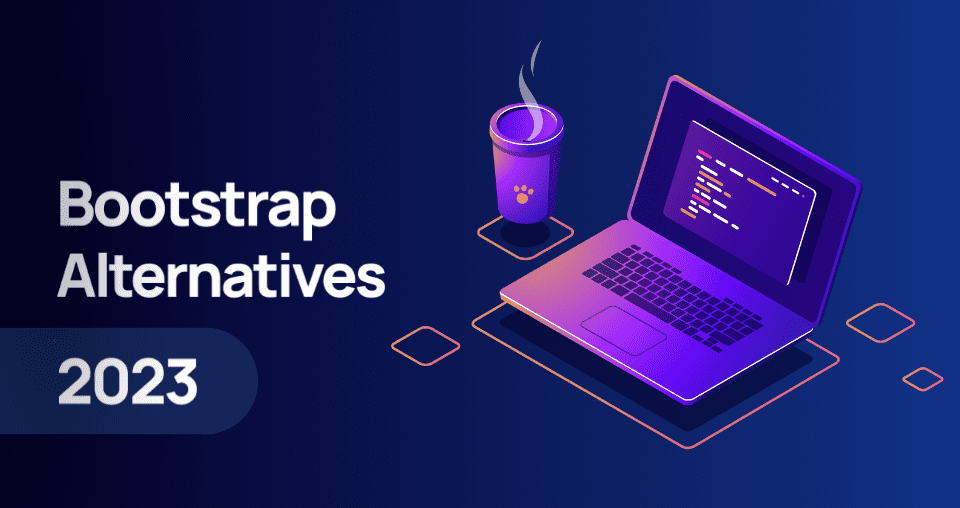7+ Bootstrap Alternatives: Best Lightweight Bootstrap Alternatives for 2024?

There is no doubt that Bootstrap is an exceptional web development framework used by millions. However, there are several bootstrap alternatives that you can use to create a website with ease while consuming less time and effort.
If you are an experienced web developer or stepping into the world of web development, learning an alternative framework can give you an extra edge and enhance your capabilities. According to the U.S. Bureau of Labor Statistics, the average salary for web developers is $88,620.
Keeping in mind the competition in the field, it’s good to expand your knowledge. Instead of listing all the alternatives to bootstrap, in this article, we’ll do an in-depth comparison of 7+ best bootstrap alternatives. So, without any further ado let’s get started.
It’s a highly customizable React UI framework purposely created to make the web development process easier and faster for developers. In Material UI all the customization is done in Javascript which is extremely common in React applications.

Features:
- Component Library: Material UI provides a comprehensive library of pre-built React components, ranging from buttons and input fields to complex components like dialogs and data grids.
- Theming and Styling: The framework offers robust theming and styling capabilities, allowing developers to easily customize the appearance of their applications to match brand or project aesthetics.
- Responsive Design: Material UI is designed with responsiveness in mind, ensuring that user interfaces adapt seamlessly to different screen sizes and devices for a consistent user experience.
- Accessibility: Accessibility is a core focus of Material UI. The framework follows best practices to ensure that applications built with it are accessible to users with disabilities, meeting web accessibility standards.

If you are comfortable working with react-based applications then this framework will be the best alternative to bootstrap. Its adaptability and intuitive structure make it a favorite choice for those seeking a smooth and efficient development experience. Also the amount of availability in terms of resources like mui templates, mui libraries & mui icons are big too, that can help you to enhance your productivity by using them.
But what if you’re not just looking for a framework but an entire solution to expedite your web development?
Introducing Modernize React MUI Dashboard Theme: This MUI Dashboard, is built on the robust foundation of Material UI and is tailored to make the dashboard creation process a breeze. Below is the Screenshot for the Modernize dashboard:
You can customize this dashboard according to your business/development needs. This material UI dashboard comes with a hell lot of options to work with. Which includes the latest:
Form layouts along with supporting elements
Amazing Tables that you can Customise
Charts layouts for your Insights
Calendars and many other options to walk through
Precisely, if you are comfortable and good at working with React then you’ll love to work on Material UI. This Bootstrap Alternative should be your go-to option.
Stats for better Analysis:
- Weekly downloads on npm: 4M
- Stars on GitHub: 87K
- Open-source contributors: 2.7K
- Followers on Twitter: 18.4K
Bulma is completely free, 100% responsive, and an open-source framework of CSS that is based on Flexbox. It is highly customizable and easy to use for creating responsive websites. It is considered to be the first framework of CSS that has implemented a flexbox grid completely.
It has one of the biggest collections of components that can be used to develop any type of website. Bulma framework has a vast range of out-of-the-box colors and requires very little effort which makes it one of the best alternatives to Bootstrap. Not to mention that it is frequently being updated for further enhancements.
Features:
- Since Bulma is an open-source framework and is continuously being updated, it can be used to create all sorts of websites.
- It is highly customizable, 100% responsive, and easy to use which makes it one of the best options for creating apps and websites for different screen sizes.
- Bulma comes with a vast range of colors , and animations, is based on Flexbox giving it an advantage in creating more attractive websites.
- If you are a developer and don’t know how to use JS plugins even then you can create eye-catching website designs by using Bulma framework only.
Pricing & Limitations:
- Bulma is a completely free and open-source framework that doesn’t cost you anything.
- If we compare Bulma framework with Bootstrap then it has comparatively less functionality and does not contain a built-in grid system like Bootstrap.
- It has been 3 years since the launch of this framework so it might be difficult for you to find tutorials and other resources. Besides having out of the box color collection its color selection is limited.
Next on the list of Bootstrap alternatives is the Materialize framework which is based on the “Material Design” principles of Google. You can think of Material Design as a design language that is created by Google. It is a combination of innovation and traditional design methods.
It is also easy to use, customizable, and has detailed documentation as well to help you in getting started. Materialize comes with Sass mixins, card designs, ripple effect animations, drag-out mobile menu, and more. This framework has many code examples as well to help you understand.
Features:
- While using materialize you don’t have to worry about writing code from scratch. It is equipped with a responsive grid system which makes your website responsive for all devices.
- Due to the availability of code examples and detailed documentation, it is very easy for new developers to get started without any hassle.
- It has animation libraries, CSS components, and a responsive grid system. Materialize also offers ripple effect animation, Sass mixins, card designs, and a drag-out the mobile menu.
Pricing & Limitations:
- You can avail of the monthly subscription to Materialize at the starting price of $16/month. For first-time users, you can use a 30-day free trial as well.
- Sometimes you might experience materialize mishandling specific components which could ruin the overall appearance.
- Doesn’t provide support for the older versions of web browsers due to which your website might not load properly for some users.
- To use the materialize framework properly you might require some prerequisite knowledge of design principles, grid system development, and CSS animation.
- Tailwind CSS
Talking about alternatives to bootstrap, our list can’t be complete without Tailwind CSS. It is also an open-source utility-first framework of CSS that can be used to create modern websites rapidly without leaving your HTML code. Tailwind CSS is equipped with classes like text-center, pt-4, rotate-90, and flex.
This framework is a perfect bootstrap alternative for those developers who want to have complete control of their projects. It doesn’t have any pre-built components and allows you to create custom components using different utilities. If you are someone who loves to create designs from scratch then this one’s for you. You can also check some ready to use Tailwind Templates to make your website and web applications much faster.
Features:
- It provides easy customization and rapid development because it is completely developed on the concept of utility classes. Also, less code is required in the CSS bundle but provides the same results as bootstrap.
- Tailwind CSS framework also has detailed documentation available for getting started just like the materialize framework.
- All the utility classes are completely responsive due to which Tailwind CSS is perfect for any sort of web design.
Pricing & Limitations:
- Just like the Bulma framework, Tailwind CSS is also open-source and completely free for development. You don’t need to pay anything for using this framework.
- It is not the first choice as a bootstrap alternative because it doesn’t have any pre-built and ready-to-use
- Maintaining the projects built using Tailwind CSS can be annoying because it is sometimes prone to errors.
- If you are not familiar with CSS then it can be challenging because it is a low-level CSS framework and is not as flexible as Bootstrap.
- Pure CSS
Pure CSS is another mobile-first and responsive CSS framework that can be considered a minimalistic, simple, and lightweight option. Pure CSS was created by Yahoo and was developed while keeping in mind the mobile devices. This is the core reason why it is lightweight and provides superior performance compared to other CSS frameworks.
You can get an idea of its size by knowing that its entire set of modules has a size of around 3.5KB when gzipped and minified. It is comparatively easy to learn and more suitable for small-scale projects. It comes with a collection of basic components. It allows you to make responsive layouts using menus, buttons, forms, grids, and much more.
Features:
- It is still a popular and active framework due to its incredibly small file size and is a perfect option for mobile devices. Pure CSS is a minimalistic alternative to bootstrap.
- Pure CSS has the Normalize.css file which offers styling and layout for UI components.
- Although this framework is a little old as it was released in 2013, it is considered as one of the bootstrap alternatives.
- This framework is modular which means every module is in a separate while. This decreases the size of your website.
Pricing & Limitations:
- Pure CSS framework is also completely free for use and you are not required to pay any sort of fee for subscription.
- It doesn’t come with any pre-built styles and you have to create everything on your own from scratch.
- Only suitable for small-scale projects because it has limited utility CSS selectors. Also, it has not received any significant improvement for a long time.
- Foundation by Zurb
Foundation by Zurb is a front-end framework used for creating responsive websites and apps with more flexible grades. It’s one of the popular alternatives to bootstrap that are unmatched by any other framework, with high-quality standards that are properly maintained.
You can get an idea of its popularity just by knowing that the big companies like HP, Amazon, eBay, and Adobe are also using the Foundation by Zurb framework. It includes rapid prototyping, a versatile grid system, and even reusable UI components. This framework is also highly customizable and very easy to learn as a beginner as it has a huge community of developers.
Features:
- This framework is not prone to errors and works without any glitches on devices of all screen sizes because of its responsiveness. It is more suitable for use when developing professional apps.
- It is very easy to set up and use due to its professional and sleek design. It even has an independent front-end framework dedicated to It also supports Ruby on Rails.
- Foundation by Zurb is a framework that has everything a developer needs including JS plugins, customization mobile-first layout system, typography, utility classes, UI components, and grid system.
Pricing & Limitations:
- Foundation by Zurb framework has a starting price of $39 per month and you can also avail its free trial for 30 days .
- This framework is not very flexible when compared to bootstrap when dealing with design for mobile devices. It is also comparatively heavier than other frameworks.
- At the start, it can be challenging for developers to use this framework because it is a robust framework.
- Skeleton
Now on our list of bootstrap alternatives is Skeleton. This framework provides you with basic components like forms, lists, tables, buttons, and much more which is enough for developers to get started. Skeleton framework is also lightweight like Pure CSS which speeds up the development process.
The reason for its popularity is its 12-column fluid grid. It is similar to CSS grids and is based on rows and columns. As a developer, you don’t need to deal with heaps of utilities like other large-scale frameworks because it is very small, simple, and straightforward. The latest versions of this framework have adopted the mobile-first approach which makes it more responsive.
Features:
- It is very suitable for small projects because it is very easy to use and lightweight. It consists of only 200 lines of code. Skeleton provides a flexible and elegant display on all browsers as it was created as mobile-first.
- If your preference as a web developer is speed and simplicity then it is a perfect option for you. Although it is not maintained regularly, it is still a great bootstrap alternative.
- One of its main features is its 12-column fluid grid layout along with responsive design that follows a mobile-first approach. It doesn’t even need installation or compilation.
Pricing & Limitations:
- You can use the Skeleton framework for free under the MIT licence . It is recommended to use CDN for JavaScript and CSS files as this makes it easier to maintain websites in the long
- It is not frequently maintained and might result in inconsistencies across newer platforms.
- Since it is not as popular as Bootstrap or Tailwind, it doesn’t have good community support due to which it can be challenging to use.
- PowerToCSS
PowerToCSS is another open-source and highly customizable framework of CSS that can be a great choice for your website. It is suitable for small projects and very easy to learn. It is based on the principles of (SMACSS) Scalable and Modular Architecture for CSS.
This framework is also small and lightning-fast compared to big names like Bootstrap etc. The class names are very easy and simple for instance .column and .button. It can be customised and allows you to add your themes. PowerToCSS is easy to learn, loads fast, and provides fast development.
Features:
- This is powered by powerful yet simple concepts like DRY CSS, and SMACSS. It can be used to automate the conversion of your static website pages into mobile-friendly web pages.
- It is much faster compared to frameworks like Bootstrap, especially in terms of website loading times. Since it is an open-source framework it offers more customization.
- The class names of the PowerToCSS framework are very simple and easy to understand like .column, and .button which makes it a better choice for new developers.
Pricing & Limitations:
- Although it is an open-source framework, its pricing is not very straightforward. It seems to be completely free for use but you might need to purchase some of its premium features.
- To use it completely with all the features you need a UI kit. It is not very popular so you shouldn’t expect much tutorials or community support.
- This framework is no longer maintained which may cause some issues in the longer run.
- Metro UI
Metro UI is the next framework on our list of bootstrap alternatives. This framework has a JS library known as M4Q just like jQuery and more than 100 components that can assist your design UI. Metro UI is interoperable with all main JavaScript frameworks & comes with built-in internationalisation support
You can think of Metro UI as one of the complete bootstrap alternatives. It is based on the Metro design language which originated from Windows. This framework follows a less typographic and terser approach. It has everything you need as a developer to build your website and front-end app.
Features:
- One of the best features of Metro UI is its compatibility with many other design languages. It is perfect for small projects with a footprint of just 10KB.
- It has a vast and active community on StackOverflow and GitHub. You can also find their official channels on different social media platforms like Facebook, X (formerly known as Twitter), and Telegram.
- This framework offers “rem” and “px” based CSS files. It is also customizable through a SASS preprocessor. This makes it compatible with major design languages.
Pricing & Limitations:
- A Free version of Metro UI is available but it contains some ads. To use the premium version you have to pay a $59 fee for support and updates for 1 year.
- The documentation available for the Metro UI framework is a little complex and confusing. Its documentation is available in only two languages: Russian & English. The English translation is not very well-versed.
- Another limitation of this framework is that it lacks consistency in its design. Also, you won’t be able to find many resources and tutorials about this framework due to its low popularity.
Conclusion
In this article, we’ve discussed all the frameworks in detail from each and every aspect to help you make the right decision. That concludes our list of 7+ best bootstrap alternatives of 2024 that you can use to level up your development experience and portfolio.





